If you need the Adobe Acrobat® Reader, click on the image at the right
Complied by Phil Nutting your Bullseye Webmaster, sail number 696.
The following is a collection of helpful hints gathered from many years of sailing and trailing boats. I hope these prove helpful. I'll add more as I think of them. Feel free to send in your tips to the Bullseye Webmaster
| Tips for Winter Storage | Tips for Springtime Preparations |
|---|---|
| Protecting Against Freeze-up | Line Types |
| Tarps and Covers | Air Tanks |
| Cleaning Lines | Updated! Yellow stains in Gel Coat |
| Updated! Cleaning Sails | Those black spots on topsides and deck |
| Cleaning Canvas | Rubbing Compound and Wax |
| Safety Equipment | Polishing Cloths |
| Standing Rigging Inspection | Trailer setup for proper tongue weight |
| Anchor Holding Power | Trailer preparation for longer rides |
| New! Trailer Winterizing | Preparing a smooth bottom for racing |
Running Rigging Changes |
Preventing Boot-top grass |
| Running Rigging | Updated! Bright Work Preparation |
| New! Standard Bullseye Rig Drawing | Mooring Inspection |
| New! Modified Bullseye Rig Drawing | Sail Measurement |
| New! Rig Modification, Jib Blocks Photos | New! Mast & Boom Trailing Support Photos |
| New! Rig Modifications, Spinnaker Block Photos | |
| New! Bow Cleat Modifications for Racing Photos | |
For boats stored outside, put some RV antifreeze in the well to prevent freezing. This
antifreeze is the kind used in drinking water systems of Recreational Vehicle during
winter storage. It won't stain the boat and is not harmful to the environment. It can be
simply pumped out and washed away with water in the spring.
Note: DON'T use regular automotive antifreeze, it is poisonous
and terrible for the environment.
For boats stored outside with tarps as covers. Check the cover during the winter months for damage and sag. Keep the cover tight. If it traps snow it can rip and fill the boat with ice and water. I like to use a high ridge pole to keep the angle of slope as steep as possible so most snow slides off.
To clean all the miscellaneous lines which get salty and dirty during a season of sailing, place the coiled lines in the top rack of the dish washer and run as a normal load. I wouldn't recommend washing dishes in the same load. Those lines really get filthy. Once they are washed, hang them out to dry and then place them in a box or bag and put in a dry place until spring. This would be a great time to inspect and repair any lines which need to be replaced, re-spliced or re-served.
To rinse and clean sails before putting them away, try filling the tub with warm water and some Snowy Flakes, Ivory Snow or Woolite. This will gently wash the sails and remove the salt. Rinse well and hangout to dry. Once the sails are dry, fold the sails and put them away until spring. This would be a good time to inspect the sails for any needed repair. Sail Lofts are usually less busy in the winter months and can have your sails repaired before that first warm spring day when everyone else wakes up and remembers they need their sails repaired.
Canvas boat covers, life jackets, seat cushions, etc. can be treated as sails and be cleaned and inspected prior to packing away for the winter.
Take this time of cleaning and packing to check to see if you have the recommended safety equipment. Maybe it is time to replace some items. Making a list now will give you an opportunity to shop the Marine Chandlery sales in the coming months before the next season starts.
When was the last time all the fittings of the mast, boom and shrouds were checked for wear? When putting away my mast I found that one of my shrouds will need to be replaced next year because the wire strands are breaking at the turnbuckle.
When replacing the shroud, adjust the length of the new shroud by matching the new shroud to the one being replaced. This will save a lot of time adjusting and tuning your standing rigging before the next race or sailing outing. An untuned rig can give odd and different sailing characteristics between port and starboard tacks.
If the chain on your anchor is less than six feet long, I'd suggest you change it to at least six feet. I prefer twelve feet of chain as it gives more holding power even with a small Danforth anchor. The idea of the longer chain is to keep the anchor biting into the bottom without lifting the shank. Make sure you have about 100 feet of anchor rhode, again to help with the holding power of the anchor. If too short a line is used it simply lifts the anchor up with each bounce of the boat.
Consider jacking up the trailer and supporting the weight on three or four jack stands. This will help the tires last longer and to keep the tires from "flat spotting" due to sitting for six months in the same position during cold temperatures. The jack stands should have a sheet of 3/4" plywood, about 18" square, placed under them if the trailer is parked on grass or dirt to prevent the jack stands from sinking into the ground.
If you have a trailer that you must submerge to launch or haul your boat, consider repacking the wheel bearings before closing up for the winter.
A coating of Vaseline on light bulb bases will help prevent corrosion, especially if you submerge your trailer for launching or hauling.
If you race and you feel that some of your lines are hard to handle, consider changing some of your running rigging to Harken® blocks. I found that with the conversion to Harken® blocks at all locations I no longer needed winches and the sails were easier to adjust especially in those really light air days.
For a look at rigging variations, check out the Standard Bullseye Rig and my Modified Bullseye Rig. I've seen many more combinations during my years of sailing and racing Bullseyes. Each one has its merits, I just haven't tried them all.
Note: For those of you who want to print out a copy of these rigs I
have created Adobe Acrobat® PDF file formats.
If you need the Adobe Acrobat® Reader, click on the image at the right
![]()
Download and print the ![]() Standard Bullseye Rig PDF
file, then download and print the
Standard Bullseye Rig PDF
file, then download and print the ![]() Modified
Bullseye Rig PDF file.
Modified
Bullseye Rig PDF file.
Here are two photos of midship jib blocks and cleats as modified on sail number 696. The cleats are designed by "Design Studio" in England. (On a recent shopping trip to my local BoatUS store I found these on the shelf for about $24.00 each.) Harken makes a similar setup (see the bottom picture), but using an upward release rather than a sideways pull to release. The sideways release works very well in all angles of heeling whereas the upwards release are a problem in heavy air and your sitting on the weather rail and need to quickly release the jib sheet. To quote the now often used phrase "been there, done that" and I didn't like it.
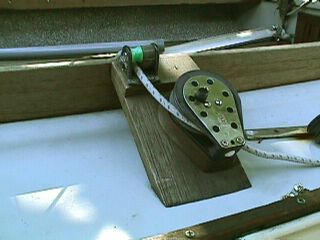
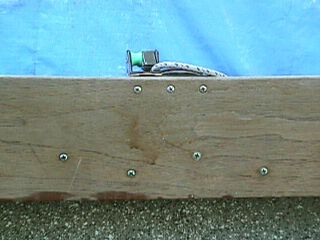
The left hand picture is of the port side as viewed from outboard and the right hand picture is as viewed from the port seat.
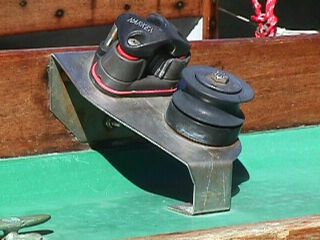
A Harken setup mounted on a custom stainless steel barcket on the starbord side as viewed from outboard of sail number 291.
The photo below shows the spinnaker blocks which were mounted on the cuddy in place of the old winches. Some people have used this configuration for jib blocks. With the spinnaker sheets setup like this you can control the spinnaker like a team of horses and be looking forward without getting in the skippers way. On a windy day it can feel like a team of unruly horses.
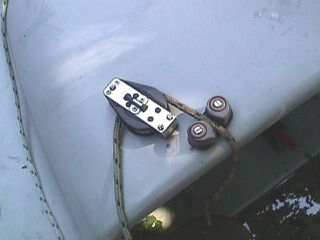
Ever had your jib sheets get caught on the bow cleat during the most important race of the season? Well, it happened once to many times, so here is a fix. Two blocks of wood (these are mahogany) which have been shaped to fit around the bow cleat and held together with a piece of bungee cord. This also works well on a stern cleat.
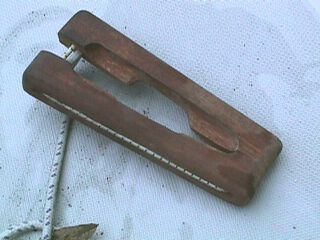
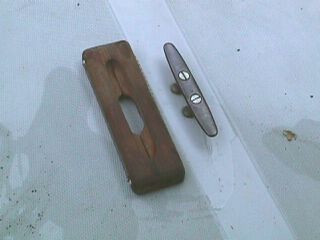
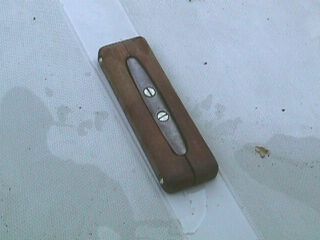
Consider braided lines instead of the traditional twisted lines. Many of the braided lines are available in many colors which is a great way to keep track of which line is which during racing.
When was the last time you checked the air tank under the cockpit sole for water? I don't know where it comes from, but what a difference it makes in sailing performance and ease of launching when the tank in dry. Most boats have a small threaded plug just aft of the mast step. A small tube can be inserted and connected to a small pump to empty this tank, but it can be a fussy and frustrating process. An effective solution, but not recommended by Cape Cod Shipbuilding, is to cut in large (6 inch) access holes with screw in covers. These can greatly improve the ability to empty the air tank, but if not sealed correctly can defeat the original purpose of the air tank, emergency floatation. Now you see why Cape Cod Shipbuilding doesn't recommend this method. Note: During the 2003 Nationals in Marion a Bullseye sank in a matter of minutes due to a leaky air tank.
As a side note, while prepping my boat for the winter this year, I open my access holes and spent the next ten minutes pumping out water that had gotten under the deck while the boat was sitting in the yard waiting for the winter cover. The air tanks were almost completely filled with water. Now you know why Cape Cod Shipbuilding does not recommend cutting holes in the air tanks.
If you find that your Gel Coat is turning yellow at the water line, look for a product called Y-10® at your local marine store or chandlery. It is a blue jelly goo you just brush on, wait a while and wash off with soapy water. Amazing stuff!
And from one of our readers;
"I note among the useful tips on your web page a recommendation of a product called Y-10 for removing yellow stains from the gelcoat around the water line. No doubt it is a fine product and does the job, but for several years I have followed the suggestion of one of my fisherman friends in downeast Maine and have used a product that is very effective, readily available, and probably cheaper than Y-10. You won't find it in your yacht chandlery. But go to the local supermarket and pick up a bottle of Lysol Toilet Bowl Cleaner. Put it on with a damp sponge or rag, leave it for five minutes and wipe it off with a wet sponge or rag. As with any powerful cleaner, you might want to wear rubber gloves, and you should be careful not to get it in your eyes. I use it on my Bridges Point 24. It works." sent in by Kent Mullikin
I tried an experiment and was amazed at the results. I used Sun Light® or Cascade®
dishwasher detergent mixed in a strong warm water solution and washed the topsides and
presto, all the little black spots were gone without having to scrub real hard.
For the white rubber rub strip use the same mixture with a ScotchBrite® pad and rub
gently and remove all the scum instantly.
The Mothers® brand of automotive compounds and waxes seem to work well. I used the compound and wax liquid products and got rid of a lot of small dark marks on the gel-coat and at the same time put on a coating of wax.
Looking through the rag box for just the right polishing cloth? Save old t-shirts (the plain ones without silk-screened logos, colored shirts are OK), velour shirts/pants (remember those from the '70s?), cloth baby diapers, old towels and dare I suggest old jockey undershorts ("whitey-tighties" as my daughter calls them).
A properly adjusted boat and trailer combination should produce only about 75 to 100 pounds of downward force on your trailer hitch. I have found that if I place the center lifting eye approximately centered over the axle of the trailer I can keep the tongue weight in the desired range. It may require adjustment of the jackscrews on the trailer but it will be well worth it each time you connect or un-connect the trailer, not to mention the ease of towing.
If your trailer is like mine, consider buying a spare tire and rim. My trailer uses a
rim which most tire machines cannot hold. If you are traveling on a weekend and have a
trailer flat you may not find a garage that can help, let a lone be open. My spare rim
cost $26 a few years ago and I used an old tire which won't pass state inspection but
holds air and will allow me to continue my trip.
While you're at it, do you have the necessary jack and lug nut wrench to change that flat
tire? Even if you are not physically able to change it yourself, at least you have the
necessary equipment when help arrives.
One problem of trailing your boat to regattas is the method of tying down the mast and boom for the long ride. Some folks use the boom crutch, but these don't support the weight of a mast well during a long ride. Other options are placing boat cushions on the cuddy and aft deck and then tying every thing down. These methods work, but each has a disadvantage. Below are pictures of custom supports made for long distance trailing. The mast support started life as a section of Zepher mast extrusion (scrap purchased from Zepher Spars) with pieces of mahogany shaped to fit into the extrusion with notches cut to support the bast and boom. The aft support is again mahogany with similar notches for the mast and boom and the butt end is shaped to fit into the boom crutch plate on the aft deck. One thing to keep in mind is, what is your tow vehicle. If you use a pickup truck with a cap you may want to make the aft support short enough so the mast clears the top of the truck cap. Don't forget the red flag on the trailing end of the mast.
The tie down scheme for trailing is as follows.
Forward from bow cleat to one jib deadeye, up and around mast/boom, down to other jib
deadeye and back to bow cleat. For added "anti-bounce" I tie a line from
the forward shroud mounting up to the mast to prevent whipping up and down from big bumps.
Aft from jib cleat to rear spinnaker deck block, up and around mast/boom, down to other
rear spinnaker block, then forward to other jib cleat.
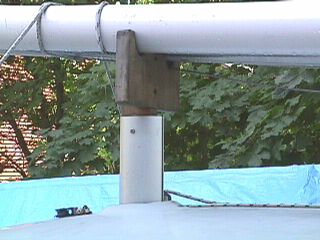
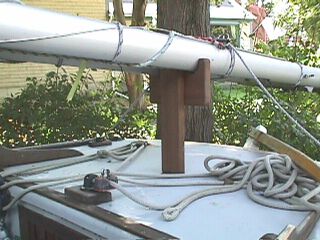
Getting the smoothest possible bottom can only help when racing. Over the years I have
worked hard at putting on the thinnest layer of bottom paint in the spring, but what
really makes a difference is wet sanding the entire bottom. The best way to do this is to
suspend the boat via its lifting eye/sling and fair out all the bumps and overlap areas
from painting around the trailer/cradle stanchions. Once this is complete, rinse and dry
the hull and inspect it for areas which still need attention. Once it is fully ready for
paint, break out the brush and paint and paint the entire bottom while suspended out of
the trailer/cradle. Make sure that you brush out the paint and paint in the direction of
the water flow.
An experiment I tried this year (because I was really late in launching... just in time
for the Nationals) was to use a Scotchbrite® pad and water to scrub the bottom and not
bother to paint the bottom. This removed the very top skin of paint and exposed the copper
from the anti-fouling paint. Hmmm? I wonder how this will retard plant and scum growth.
I'll let you know in October when we haul out.
October has come and gone. The boat is finally under winter cover. On haul-out day I was pleased with the very small amount of scum growth on the hull. However I did not give the full test of a complete sailing season. Generally in a full season the boat is hauled several times to remove the scum to keep the boat clean for racing, especially before the Nationals
Over the years many people have eliminated the boot stripe from their boat preparation for two reasons, it means another color paint to cut (mask) in and dry as well as having grass and scum grow on the boot stripe. I eliminated this problem by using anti-fouling paint for my boot stripe. There is something pretty about the contrasting color of a boot stripe. I was lucky enough to find some white anti-fouling paint which I could then tint (using standard tinting colors from a local paint and wallpaper store) to my desired color of light blue.
Bright work is always a problem to maintain. I used to use Teak Oil on my bright work until I realized that the seat of my sailing shorts were getting black after each day of sailing. (Not very attractive when walking home.) I have switched to using a product called "Deks Olje®." (I'm going to check on the spelling.) This does not turn your cloths black and seems to do an excellent job of protecting the wood. Two words of caution, try not to get it on the fiberglass as it will discolor it and clean out the brush as soon as your done. The brush will turn rock hard if not cleaned out.
An alternative, although probably not recommended by the products manufacturer, is Thompsons Waterproof® (NOT Thompsons WaterSeal®!... this stuff is paraffin based and actually attracts dirt like a magnet.) I discovered Thompsons Waterproof® after building my porch/deck behind the house. It smells and works just like Deks Olje®. I put two coats on the porch decking in late summer and now the water beads up and runs off. Wow!
For those of you looking for Deks-Olje, here is the manufacturer's information.
It should be available at marine supply stores. If not I have listed the manufacturer's information below.
The Flood Company
PO Box 2535
Hudson, Ohio 44236-0035
phone: 800-321-3444
fax: 330-650-1453
www.floodco.com
There are two products Deks-Olje #1 "Clear Wood Finish" and Deks-Olje #2 "Clear Wood Finish".
Before you put the boat on the mooring, when was the last time you inspected all the
chain and lines of your mooring gear. Several years ago I got a call at midnight from the
local police that my boat was heading for the rocks. I had used a less expensive
traditional twisted line which I had spliced onto the thimble. It had managed to unsplice
itself! My line now consists of a braided line which won't come unspliced.
Consider a nylon (plastic) thimble for the connection to the chain. My galvanized thimble
has rusted away to nothing and the line is starting to wear.
It is recommended that new sails be measured, even if there is no immediate plan to
compete, at the first possible Nationals after delivery to reduce the possibility of sail
stretch causing the sail to be considered out of specification at future Nationals
competitions.
Let's face it, sails change shape after they have been used for a season. Now sail for
three or four seasons and you have some major changes in sail dimensions. If you were to
take these "old" sails to a Nationals competition, assuming they had never been
measured at a Nationals, they would most likely measure out of specification. Don't whine
to your sailmaker! Sails are considered consumable items just like brakes, mufflers, tires
and motor oil on a car. They stretch and wear out.
The solution is to find a way to get your new sails measured and marked at a Nationals
before you take them out in a heavy gale. Then if the Nationals happen to be in your
"backyard" you can enter and not have to get your sails recut prior to being
able to race.
Home | The Evolution | The Features & Construction | Cape Cod Shipbuilding | Bylaws | Tech Specs | Regatta Results | Hints | Trailers | Sails | Boats & Parts | Photographs | Rules for Conducting Regattas | Sailing Instructions
These pages designed and maintained by the Bullseye Association • Copyright 1997 - 2004